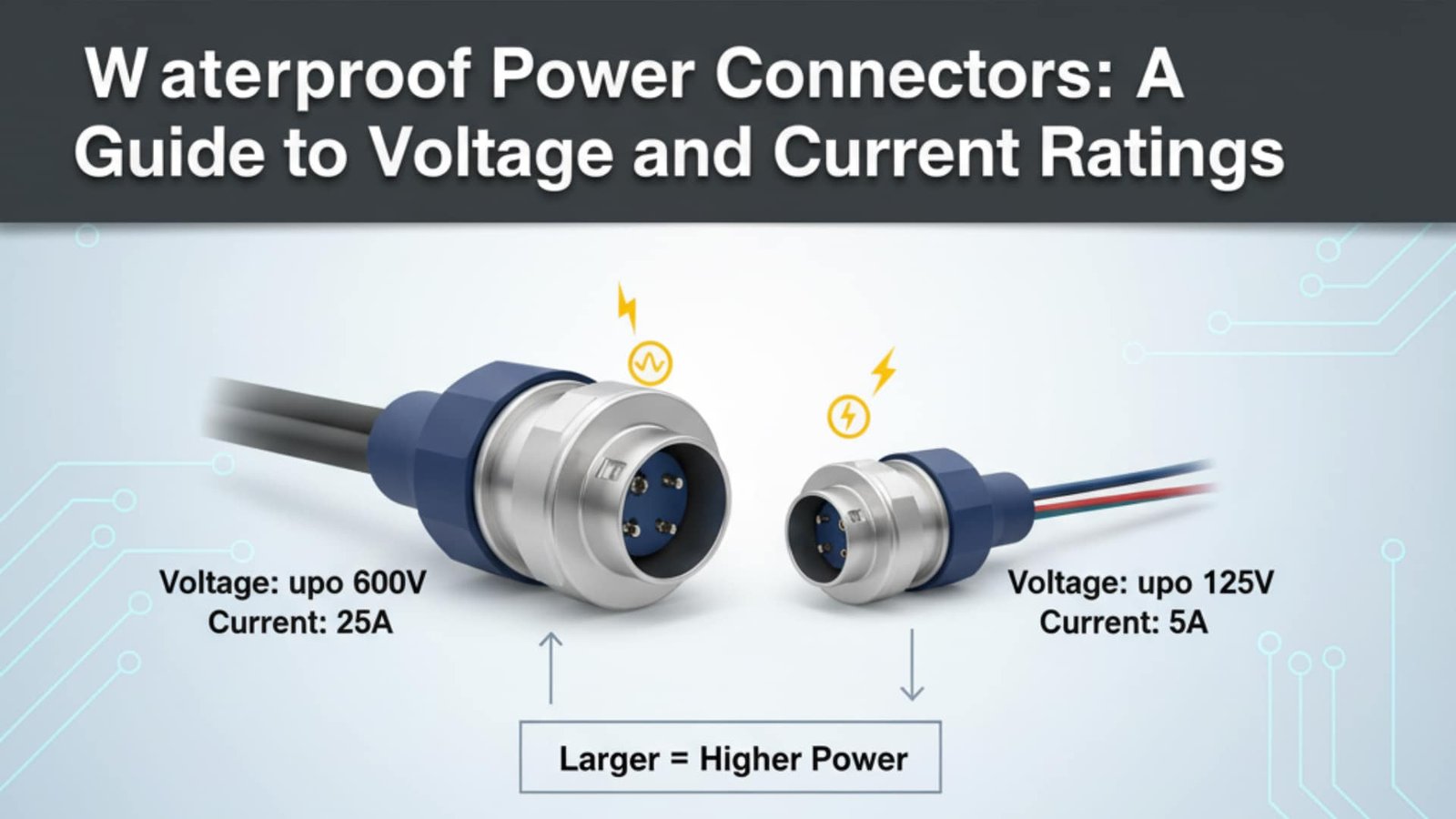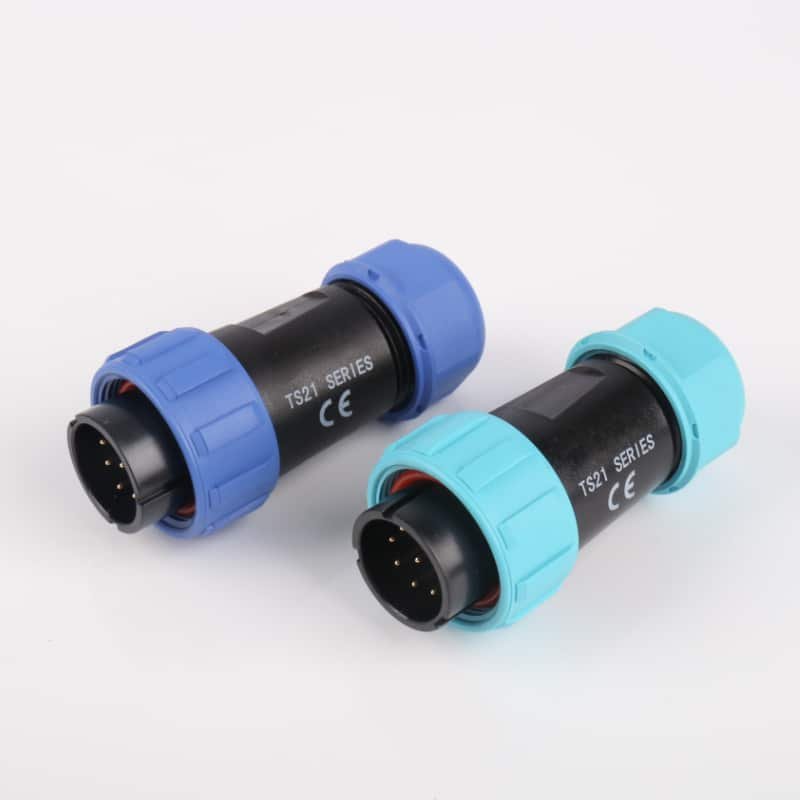Selecting the wrong voltage or current rating for waterproof power connectors can lead to catastrophic system failures, equipment damage, and safety hazards that cost thousands in repairs and downtime. The complexity of matching electrical specifications with environmental protection requirements often overwhelms even experienced engineers. Waterproof power connectors must be rated for at least 125% of your system’s operating voltage and current to ensure safe, reliable operation – with ratings typically ranging from 12V/5A for low-power applications to 1000V/630A for industrial high-power systems. After helping countless engineers at Bepto Connector navigate these critical specifications over the past decade, I’ve witnessed how proper rating selection can make the difference between project success and costly field failures.
Table of Contents
- What Are the Key Electrical Rating Parameters for Waterproof Power Connectors?
- How Do Environmental Factors Affect Voltage and Current Ratings?
- What Safety Margins Should You Apply When Selecting Ratings?
- How Do Different Connector Types Compare in Terms of Power Handling?
- What Common Rating Mistakes Should You Avoid?
- FAQ
What Are the Key Electrical Rating Parameters for Waterproof Power Connectors?
Understanding electrical ratings prevents dangerous misapplications and ensures optimal performance. Key parameters include voltage rating (maximum safe operating voltage), current rating (continuous amperage capacity), power rating (voltage × current), and derating factors for temperature, altitude, and environmental conditions – all critical for safe connector selection.

Voltage Rating Fundamentals
Operating Voltage vs. Rated Voltage: The rated voltage represents the maximum continuous voltage a connector can safely handle. Operating voltage should never exceed 80% of the rated voltage for reliable long-term performance.
AC vs. DC Considerations: DC voltage ratings are typically higher than AC ratings for the same connector due to the absence of voltage peaks. A connector rated for 250V AC might handle 600V DC safely.
Insulation Voltage: This critical parameter indicates the maximum voltage the insulation can withstand without breakdown. Quality waterproof connectors feature insulation voltages 2-3 times higher than their operating voltage ratings.
Current Rating Specifications
Continuous Current Rating: This represents the maximum current a connector can carry continuously without exceeding temperature limits. Ratings assume specific ambient temperatures (typically 20°C) and proper ventilation.
Contact Resistance Impact: Lower contact resistance enables higher current capacity. Our brass waterproof connectors typically achieve <5mΩ contact resistance, while premium gold-plated versions reach <2mΩ for maximum current handling.
Marcus, a project manager from a wind farm in Denmark, initially selected 20A-rated waterproof connectors for his 18A turbine control systems. However, he didn’t account for temperature derating in the harsh Nordic environment. After experiencing several connector failures during summer peaks, we upgraded him to 30A-rated connectors with enhanced thermal management. His turbines have now operated flawlessly for over two years, generating consistent revenue without weather-related downtime.
Power Rating Calculations
Real Power vs. Apparent Power: For AC applications, consider both real power (watts) and apparent power (VA). Reactive loads require connectors rated for the full apparent power, not just real power consumption.
Surge Current Handling: Many applications experience startup surges 5-10 times normal operating current. Ensure your connector can handle these transient conditions without damage.
How Do Environmental Factors Affect Voltage and Current Ratings?
Environmental conditions significantly impact electrical performance and safety margins. Temperature increases reduce current capacity by 2-3% per °C above 20°C, while humidity and altitude can lower voltage ratings by up to 20% – making environmental derating1 essential for reliable operation.
Temperature Derating Effects
Thermal Management Principles: Higher temperatures increase conductor resistance and reduce insulation effectiveness. Standard derating curves show 10-15% capacity reduction at 40°C ambient temperature.
Heat Dissipation Considerations: Enclosed installations trap heat, requiring additional derating. Panel-mounted connectors in sealed enclosures may need 25-30% current derating compared to free-air installations.
| Temperature (°C) | Current Derating Factor | Voltage Derating Factor |
|---|---|---|
| 20 | 1.00 | 1.00 |
| 40 | 0.85 | 0.95 |
| 60 | 0.70 | 0.90 |
| 80 | 0.55 | 0.85 |
Humidity and Contamination Impact
Insulation Degradation: High humidity reduces insulation effectiveness, particularly in connectors with hygroscopic materials. IP68-rated connectors maintain performance in 95% relative humidity conditions.
Corrosion Effects: Salt spray and industrial contaminants increase contact resistance over time. Marine-grade waterproof connectors use specialized coatings and materials to maintain electrical performance in harsh environments.
Ahmed, who operates a desalination plant in Kuwait, faced recurring connector failures in his high-humidity, high-temperature pump control systems. His original 400V/32A connectors couldn’t handle the combined stress of 45°C ambient temperature and 90% humidity. We specified marine-grade stainless steel connectors with enhanced sealing and 50% voltage/current derating. The upgrade eliminated his monthly maintenance issues and reduced operating costs by $25,000 annually.
Altitude Considerations
Air Density Effects: Reduced air density at altitude decreases cooling effectiveness and lowers dielectric strength2. Connectors operating above 2000m typically require 10-20% derating.
Corona and Arcing Risks: Lower air pressure increases corona discharge risk at high voltages. Applications above 3000m altitude may need specialized high-altitude rated connectors.
What Safety Margins Should You Apply When Selecting Ratings?
Proper safety margins prevent failures and ensure long-term reliability. Apply minimum 25% safety margin for voltage ratings and 20% for current ratings, with additional margins for harsh environments, critical applications, or systems with poor maintenance access – conservative sizing prevents costly failures.
Standard Safety Margin Guidelines
Voltage Safety Factors:
- General applications: 25% minimum margin
- Critical systems: 50% margin
- Harsh environments: 40-60% margin
- Poor maintenance access: 50% margin
Current Safety Factors:
- Continuous operation: 20% minimum margin
- Intermittent duty: 15% margin
- High-vibration environments: 30% margin
- Temperature cycling: 25% margin
Application-Specific Considerations
Motor Starting Applications: Inrush currents can reach 6-8 times normal running current. Size connectors for full locked-rotor current3, not just running current.
Switching Transients: Inductive loads create voltage spikes during switching. Use connectors rated for at least 150% of supply voltage when switching inductive loads.
Fault Current Capability: Consider short-circuit current levels in your system. Connectors should withstand fault currents until protective devices operate.
Long-Term Reliability Factors
Contact Wear Considerations: Repeated mating cycles gradually increase contact resistance. High-quality gold-plated contacts maintain low resistance through 1000+ mating cycles.
Seal Degradation: O-ring seals gradually lose effectiveness over time. Plan for seal replacement or specify connectors with replaceable sealing elements for long-term applications.
How Do Different Connector Types Compare in Terms of Power Handling?
Connector design significantly impacts power handling capabilities. Circular waterproof connectors typically handle 5-630A current ranges, rectangular connectors manage 10-400A, while specialized high-power designs reach 1000A+ – with contact count, material selection, and cooling design determining maximum ratings.
Circular Connector Power Capabilities
Standard Circular Designs: M12 connectors typically handle 4-16A, M16 versions manage 10-25A, while M23 and larger sizes accommodate 25-63A continuous current.
High-Power Circular Variants: Specialized high-current circular connectors with large pin sizes and enhanced cooling can handle 100-400A for industrial applications.
Contact Configuration Impact: Fewer, larger contacts handle more current than many small contacts. A 3-pin high-power connector often outperforms a 12-pin standard design for power applications.
Rectangular Connector Advantages
Power Distribution Benefits: Rectangular connectors efficiently package multiple high-current contacts in compact housings, ideal for power distribution panels.
Thermal Management: Larger housing volumes provide better heat dissipation, enabling higher current ratings in rectangular formats.
Modular Flexibility: Mix power and signal contacts in single rectangular connectors, reducing installation complexity and panel space requirements.
Specialized High-Power Designs
| Connector Type | Typical Current Range | Voltage Range | Key Applications |
|---|---|---|---|
| M12 Circular | 4-16A | 30-250V | Sensors, small motors |
| M23 Circular | 25-63A | 250-600V | Medium power motors |
| Rectangular Power | 50-400A | 600-1000V | Industrial drives |
| High-Power Circular | 100-630A | 1000V+ | Heavy industrial |
Material Impact on Power Handling
Contact Materials: Copper alloy contacts provide excellent conductivity for high-current applications. Silver-plated copper offers the best performance for maximum power handling.
Housing Materials: Metal housings dissipate heat better than plastic, enabling higher current ratings. Aluminum and brass housings support 20-30% higher current than equivalent plastic designs.
What Common Rating Mistakes Should You Avoid?
Rating mistakes create safety hazards and reliability problems. Common errors include ignoring derating factors, confusing AC/DC ratings, overlooking surge currents, and failing to account for contact resistance increases over time – proper specification review prevents these costly mistakes.
Voltage Rating Mistakes
Peak vs. RMS Confusion: AC voltage ratings typically specify RMS values. Peak voltages in AC systems reach 1.414 times RMS values, potentially exceeding connector ratings.
Transient Voltage Neglect: Switching transients, lightning, and motor starting create voltage spikes well above normal operating levels. Always consider transient voltage levels in your rating calculations.
Series Connection Errors: Connectors in series must each handle the full system voltage. Don’t assume voltage division across multiple connectors.
Current Rating Oversights
Ambient Temperature Assumptions: Standard current ratings assume 20°C ambient temperature. Higher temperatures require significant derating that many engineers overlook.
Duty Cycle Misunderstanding: Intermittent duty ratings allow higher currents for short periods. Continuous operation requires full derating to continuous current specifications.
Contact Count Confusion: More contacts don’t always mean higher current capacity. Contact quality and size matter more than quantity for power applications.
Environmental Factor Neglect
Altitude Impact Ignorance: High-altitude installations require derating that’s often overlooked in standard applications. Mountain installations and aircraft applications need special consideration.
Vibration Effects: High-vibration environments loosen connections and increase contact resistance. Specify connectors with enhanced retention and vibration resistance for these applications.
Corrosion Underestimation: Marine and industrial environments accelerate contact corrosion. Standard ratings may not apply in corrosive atmospheres without proper material selection.
Conclusion
Proper voltage and current rating selection for waterproof power connectors requires careful consideration of electrical requirements, environmental conditions, and safety margins. The investment in correctly specified connectors pays dividends through reliable operation, reduced maintenance, and eliminated safety hazards. At Bepto Connector, we help engineers navigate these complex specifications daily, providing detailed technical support and application guidance. Remember: conservative rating selection with appropriate safety margins prevents expensive failures and ensures long-term system reliability. When electrical safety is paramount, never compromise on connector specifications 😉
FAQ
Q: What’s the difference between AC and DC voltage ratings for waterproof connectors?
A: DC voltage ratings are typically 2-3 times higher than AC ratings for the same connector due to the absence of voltage peaks and different insulation stress patterns. A 250V AC rated connector might safely handle 600V DC.
Q: How much should I derate current ratings for high temperature applications?
A: Derate current capacity by 2-3% per degree Celsius above 20°C ambient temperature. At 60°C, expect 25-30% current reduction from standard ratings, requiring significantly larger connectors for the same current.
Q: Can I exceed voltage ratings briefly during startup or switching?
A: Brief voltage excursions up to 110% of rated voltage are typically acceptable for quality connectors, but repeated overvoltage stress reduces connector life. Design systems to limit transient voltages through proper surge protection.
Q: Why do my waterproof connectors get hot during normal operation?
A: Heat generation indicates excessive current density or poor connections. Check actual current levels, verify proper contact engagement, and ensure adequate ventilation. Consider upgrading to higher-rated connectors if heating persists.
Q: How do I calculate power rating for three-phase waterproof connectors?
A: For three-phase systems, calculate power as √3 × voltage × current × power factor. Each phase conductor must handle the full line current, so size connectors based on individual phase current requirements, not total system power.
-
Explore the concept of derating, the practice of operating an electrical component at less than its maximum rated capacity to improve reliability and lifespan. ↩
-
Understand dielectric strength, a measure of an insulating material’s ability to withstand electrical stress without breaking down and conducting current. ↩
-
Discover the phenomenon of locked-rotor current, the high current drawn by an AC motor when its rotor is stationary, which can be 6-8 times the normal running current. ↩




